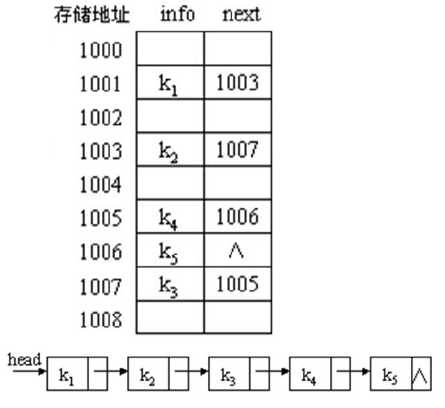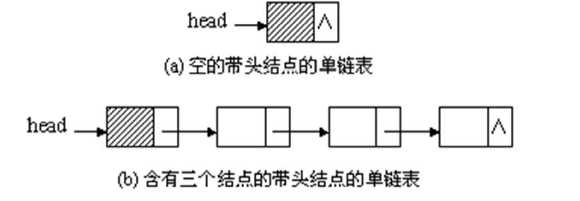标签:count res 长度 代码 技术 删除节点 img 函数 第一个
一、单链表简介
相对于以数组为代表的“顺序表”而言,单链表虽然存储密度比较低(因为数据域才是我们真正需要的,指针域只是用来索引,我们并不真正需要它),但是却具有灵活分配存储空间、方便数据元素的删除、方便元素插入等优点
单链表是线性表链式存储的一种,其储存不连续。单链表的数据结构中包含两个变量:数据和指向下一结点的指针。一个结点只知道下一个结点的地址。一个单链表必须有一个头指针,指向单链表中的第一个结点。否则链表会在内存中丢失。
一般的链表可以不带头结点,头指针直接指向第一个节点,如下图:

但是这样的链表有一个很大的问题,就是元素插入与删除操作时,需要考虑是否要改动头指针,而改动指针如果反应在函数中,那么形参必须使用二重指针,既加大了编写程序的难度,而且还降低了可读性,容易出错,因此“带头结点的单链表”使用更方便,也就是头指针指向的节点不存放数据,只作为链表的开始,这样一来,针对第一个节点的操作和针对其他节点的操作就完全一样的,十分方便,如图所示:

二、带头结点的单链表各种操作
下面我们讨论一下带头结点的单链表的各种操作
1、链表数据结构的声明
1 using namespace std; 2 const int MAXSIZE = 1000; 3 template <class T> 4 struct Node 5 { 6 T data; //数据域 7 Node *next; //指针域 8 };
2、链表模板类的声明
1 template <class T> 2 class LinkList 3 { 4 public: 5 LinkList(){front = new Node<T>;} //the constructor function without arguments 6 LinkList( T a[], int n); //the constructor function initialized by array of n elements 7 ~LinkList(); 8 int GetLength(); //get the length of the LIST 9 void PrintList(); //print the element of the list 10 void Insert(int i,T x);// insert element x in the i-th location 11 T Delete(int i); //delete the i-th element and return its value 12 Node<T> *Get(int i); //get the address of i-th element 13 int Locate(T x); //find the element whose value is x and return its index 14 private: 15 Node<T> *front; //head pointer 16 };
3、用头插法建立新链表,也就是每次插入的新节点都在链表的头部,注释部分给出的是尾插法的实现方式
1 template <class T> 2 LinkList<T>::LinkList(T a[], int n) 3 { 4 // insert element at the first location of the existing link list 5 front = new Node<T>; 6 front->next = NULL; 7 for(int i=n-1; i>=0; i--) 8 { 9 Node<T> *s = new Node<T>; 10 s->data = a[i]; 11 s->next = front->next; 12 front->next = s; 13 } 14 // insert element at the tail of the existing link list 15 16 /* 17 front = new Node<T>; 18 Node<T> *r = front; 19 for(int i=0; i<n; i++) 20 { 21 Node<T> *s = new Node<T>; 22 s->data = a[i]; 23 r->next = s; 24 r=s; 25 } 26 r->next = NULL; 27 */ 28 }
4、打印链表
1 template <class T> 2 void LinkList<T>::PrintList() 3 { 4 Node<T> *p = front; 5 if(p->next==NULL) 6 cout<<"link is enpty"<<endl; 7 else 8 { 9 p = p->next; 10 while(p) 11 { 12 cout<<p->data<<" "; 13 p = p->next; 14 } 15 } 16 }
5、插入节点
1 template <class T> 2 void LinkList<T>::Insert(int i,T x) 3 { 4 Node<T> *p = front; 5 if(i!= 1) p=Get(i-1); // if not insert the elelment in the first location 6 if(p) 7 { 8 Node<T> *s = new Node<T>; 9 s->data = x; 10 s->next = p->next; 11 p->next = s; 12 } 13 else 14 cout<<"error!"<<endl; 15 }
6、删除节点
1 template <class T> 2 T LinkList<T>::Delete(int i) 3 { 4 Node<T> *p = front; 5 if(i!=1) p = Get(i-1); 6 Node<T> *q = p->next; 7 p->next = q->next; 8 T x = q->data; 9 delete q; 10 return x; 11 }
7、按位查找节点,返回第i个节点的地址
1 template <class T> 2 Node<T> *LinkList<T>::Get(int i) 3 { 4 Node<T> *p = front->next; 5 int j=1; 6 while(p&&j!=i) 7 { 8 p = p->next; 9 j++; 10 } 11 return p; 12 }
8、按值查找,返回给定值对应的节点的序号
1 template <class T> 2 int LinkList<T>::Locate(T x) 3 { 4 5 Node<T> *p = front->next; 6 int j=1; 7 while(p) 8 { 9 if(p->data==x) return j; 10 p = p->next; 11 j++; 12 } 13 return -1; //search fail 14 }
9、获取链表长度
1 template <class T> 2 int LinkList<T>::GetLength() 3 { 4 Node<T> *p = front->next; 5 int count=0; 6 while(p) 7 { 8 p = p->next; 9 count++; 10 } 11 return count; //get the length of linklist 12 }
10、析构函数
1 template <class T> 2 LinkList<T>::~LinkList() 3 { 4 Node<T> *p = front; 5 while(p) 6 { 7 front = p; 8 p = p->next; 9 } 10 }
11、主函数(由于使用模板类实现,以上所有代码建议放入 .h头文件,主函数则放入.cpp文件 所有代码在dev c++环境中测试通过)
1 /* 2 线性表相关成员函数的实现 3 */ 4 #include <iostream> 5 #include <cmath> 6 #include <stdlib.h> 7 #include "linked_list.h" 8 using namespace std; 9 int main() 10 { 11 int a[7] = {1,2,3,4,5,6,7}; 12 LinkList <int> list(a,7); 13 list.PrintList(); 14 cout<<endl; 15 cout<<list.Get(3)<<endl; 16 Node<int> temp = *list.Get(3); 17 cout<<temp.data<<endl; 18 //cout<<*(list.Get(3))<<endl; 19 cout<<list.GetLength()<<endl; 20 list.Insert(3,11); 21 cout<<list.GetLength()<<endl; 22 list.PrintList(); 23 cout<<list.Locate(5)<<endl; 24 int x = list.Delete(4); 25 cout<<"删除元素:"<<x<<endl; 26 list.PrintList(); 27 //int p = list.Locate(1000); 28 //cout<<"元素4的位置:"<<p<<endl; 29 system("pause"); 30 return 0; 31 }
标签:count res 长度 代码 技术 删除节点 img 函数 第一个
原文地址:http://www.cnblogs.com/dapeng-bupt/p/6978354.html